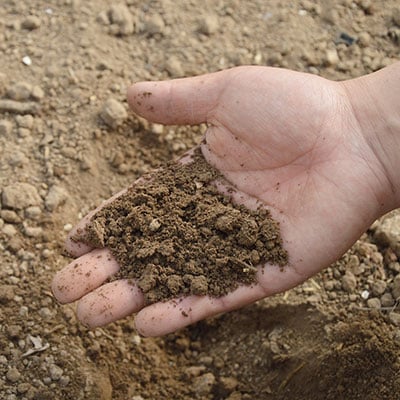
Every garden starts with the soil that's supporting the growth of plant life. Whether gardeners are completely new to the experience or are maintaining an already established garden, it's important to take the soil being used into consideration in order to improve the overall health and vitality of a garden. So, what's involved in knowing soil and what's actually usable for gardening?
Drainage
The word “drainage” is thrown around quite a bit in gardening, but the most basic rule is that the majority of plants will prefer well-drained soil: that is, soil that has access to drainage planes or can easily draw or remove moisture as required. This means gardeners are best to avoid choosing sites that are prone to flooding or pooling after heavy rainfalls, or even during the day-to-day upkeep of gardens using a hose.
Ideal soil is soft throughout. There shouldn't be any hard layers, especially those forming around the top towards the surface which is generally indicative of poor drainage. If gardeners find this to be the case, then they'll need to seek an alternative site for their garden altogether unless they're choosing plants that don't require well-drained soil. If a particular site is all that gardeners have available to them, then they may want to consider raised beds. This will help keep the root structure out of the poorly drained soil in order to help establish it more fully.
Existing Vegetation
What's already established within a site, even if it's just a lawn, is a key indication to how a garden would thrive in any one particular location. If a site has a flourishing green lawn that's otherwise healthy and growing as it should, then it's very likely that it would be a suitable spot for gardening. On the other hand, if the area is marred with weeds, poor or damaged growth, or any other unkempt features, then that should be taken as a clear indication that the site isn't suitable for gardening or will require significant improvement before it will be made suitable.
Soil Exploration
Gardeners should also take it upon themselves to have a look around their prospective gardening site. Exploring the soil involves digging down to at least twelve inches within the soil, while seeking hard layers. If any of these make themselves known, then the site should be deemed unfit for gardening. Any signs of life beneath the surface, such as earthworms, are positive.
Soil Colour
Gardeners should aim to use the darkest soil possible. Dark soil is indicative of organic matter, which is the most suitable option for gardening as most vegetation thrives in soils that are high in organic matter. However, it's rare to find this sort of colour within the typical garden.
Light browns to reds are usable soils. These colours are typically associated with good levels of drainage and high levels of oxygen. However, bluish or greenish tints are usually indicative of constant saturation. This isn't good for most gardens or plants as the soils are usually poorly drained in these situations. Yellow tints should also be taken with caution. There is drainage present in yellow soils, but it is usually poor or following an imperfect path.
Soil Texture
The texture of the soil can reveal quite a lot of information as to what's going on beneath the surface. Sandy soils are often very porous and will require constant watering due to their excessive drainage. On the other hand, clay soils are unlikely to drain at all and cannot be over watered. These are two extremes and aren't typically found in many household gardens, but understanding the texture of the soil will allow gardeners to make more informed decisions about their plants.
Many universities, extension offices and local councils offer guidance regarding soil testing. Basic soil testing will tell gardeners the particulars of what they're dealing with and allow them to choose the plants most suitable for their soil. Some tests will also provide key tips on whether or not to lime the soil, add sulphur, or provide other tips in adjusting the acidity of the soil. Urban soil tests are also important to help avoid soils that are particularly high in atmospheric contaminants.




